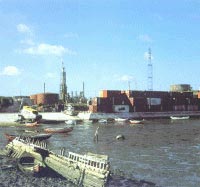 |







|
| Degradation and
Pollution |
| The Park of Nations is
situated in the eastern quarter of the city of Lisbon, in a transition area between the
municipalities of Lisbon and Loures. Its physical limits are the Av. Marechal Gomes da
Costa, to the south, the river Trancão, to the north, the Tagus estuary to the east and
the northern railway line to the west. |

© Parque EXPO'98 / Homem à Máquina |
 The Park of Nations was occupied by large industrial
infrastructures, namely the Petrogal refinery and deposits from the petrol industry
(formerly Sacor and other companies, occupying around 50 hectares), the Industrial
Abattoir of Lisbon, the General War Materials Depot, the Waste Waters Treatment Plant, the Waste Landfill and the
Solid Waste Treatment Plant (ETRS) of Beirolas, besides various installations of the port
and other similar activities. The Park of Nations was occupied by large industrial
infrastructures, namely the Petrogal refinery and deposits from the petrol industry
(formerly Sacor and other companies, occupying around 50 hectares), the Industrial
Abattoir of Lisbon, the General War Materials Depot, the Waste Waters Treatment Plant, the Waste Landfill and the
Solid Waste Treatment Plant (ETRS) of Beirolas, besides various installations of the port
and other similar activities. |
![[ Redevelopment Area in 1993 ]](../../images/expo/ambiente/expo_amb_comoera2.jpg) |
In the
area immediately to the west of the railway line other small and medium-sized industries
were also installed in a fairly haphazard way in terms of urban planning.
The main reasons explaining
the state of decay and pollution reached in the Park of Nations before the intervention of
the Parque EXPO – the Entity responsible for the realisation of the 1998 World
Exposition and for the work necessary for its success – were due mainly to:
- The type of industries and the stage at
which they were established, corresponding to a period when environmental concerns and the
technical means to improve the environment were only just beginning;
- The way these industries were established,
which at that time paid little attention to questions of urban organisation;
- To the nature of the ownership of a large
percentage of the land, maintained in a state of expectancy, but without control in
respect of situations of clandestine use, such as the dumping of rubbish and construction
debris;
The encompassing of the industrial port
zone by the urban fabric, creating a situation of a conflict of interests which would
progressively question its established vocation in view of the greater dynamism of its
"urban" use and the inability to find an answer to the installed uses and their
development. |
|

